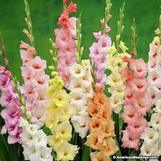|
Ozark Green Thumb BCMG Monthly e-Newsletter |
|
|
 Latin: Gladiolus x hortulanusGladiolus are too common and mundane to be cool in the garden. The omission of gladiolus from the garden is understandable because its blooms are fleeting - usually lasting for less than a week in any kind of pristine state - and its form is somewhat wanting. Yet, surprisingly, the gladiolus is one of the most important summer "bulb" crops with some production in every state of the Union. Gladiolus plants have been known since ancient times but it was not until the introduction of the African species into European gardens in the 18th and 19th centuries that hybridizers began to create the garden forms we know today. About 250 distinct species of gladiolus are described with about 15 species native in the Mediterranean region. Only the African species have been used in developing modern hybrids. The most notable of the African collectors was James Bowie (1789-1869) who initially collected for Kew Gardens in England, but was let go when the plant collecting budget was halved in 1820. His dismissal may have also reflected the riotous life style he developed while afield in remote parts of the world. Unable to find a governmental sponsor, Bowie returned to South Africa as a private collector where he worked on a consignment basis. The glad’s 15 minutes of fame came early in the 20th century when hybridizers such as Lemoine in France and Luther Burbank in California focused their attention on the plant. In 1910, the American Gladiolus Society was founded to promote the growing of glads and to standardize nomenclature. But the gladiolus craze seems to have subsided by mid century, primarily because gladiolus is just not a tidy garden plant. Another contributing factor to the flower’s decline in popularity was psychological. Florists began using it as a cheap and readily available funeral flower, and only the most intrepid supporter will stay faithful to a flower associated with bereavement. The gladiolus, a member of the iris family, does not produce a true bulb but instead reproduces by means of a corm. If cut in half, a corm is a solid starchy mass with no apparent internal structure such as you find in a true bulb. If the tunic is pulled away and the surface of the corm inspected a series of concentric rings will be found which correspond to the nodes of a typical plant. Each year, the corm is consumed to accomplish the above ground growth of the plant with a new corm formed atop the old one as the plant begins to flower. In addition to the main corm a number of pea-sized cormels will be produced which will attain flowering size in two growing seasons. The vegetable garden is probably the best place to grow gladiolus corms. By making multiple plantings from early to mid April until late July, cut blooms can be enjoyed all season long. If you wish to use the plants in the flower border, plant the corms in clumps of a dozen or so in an area about the size of a dinner plate. A wire support, such as a tomato cage, will be required to keep the plants from toppling, but the spiky four foot tall inflorescence can add some nice vertical lines to the flower border. Single colors are best for this use. Gladiolus can be left in the garden year round in most parts of the state, but hard winters which freeze the soil to the depth of the corm will kill them. Most people that grow gladiolus for cut flowers dig their plants each fall and store the corms in a dry, frost free area over winter. By: Gerald Klingaman, retired Extension Horticulturist - Ornamentals Extension News - July 14, 2000
0 Comments
Leave a Reply. |
Archives
April 2022
|
|
